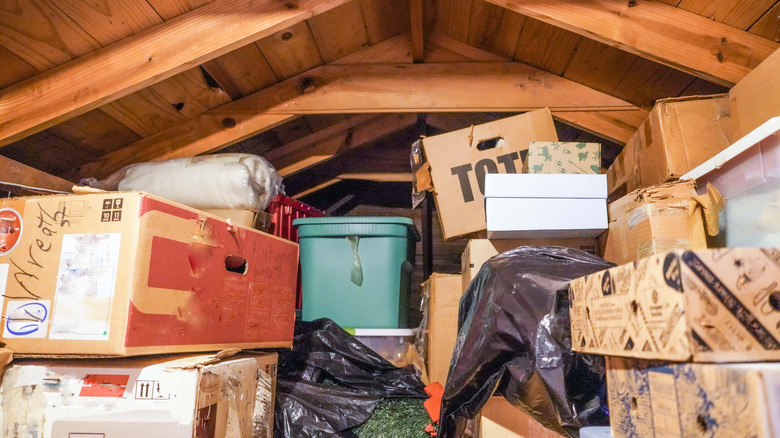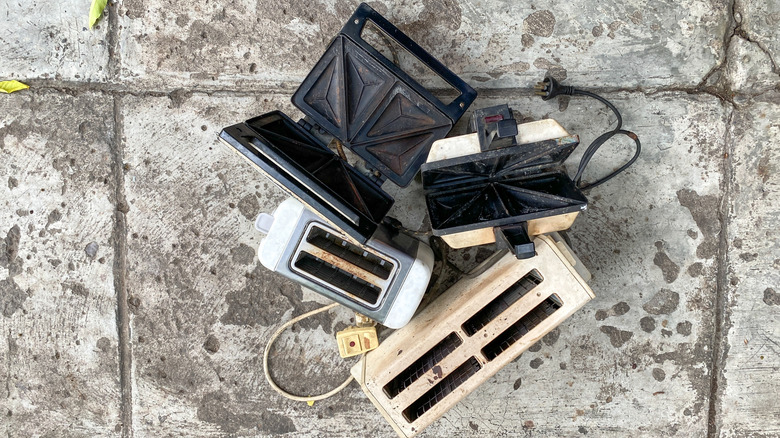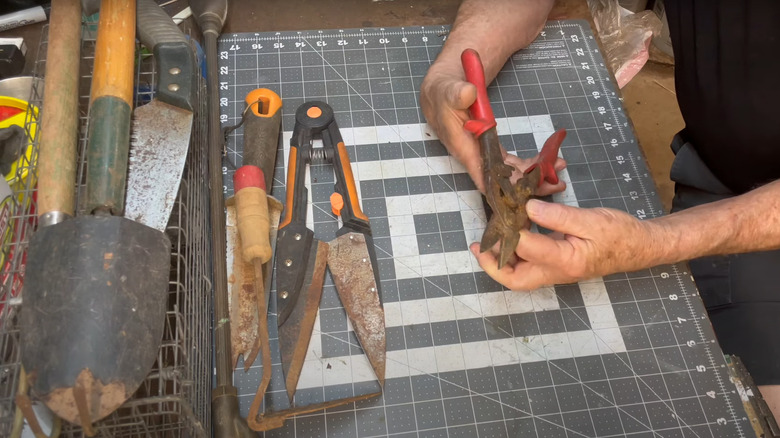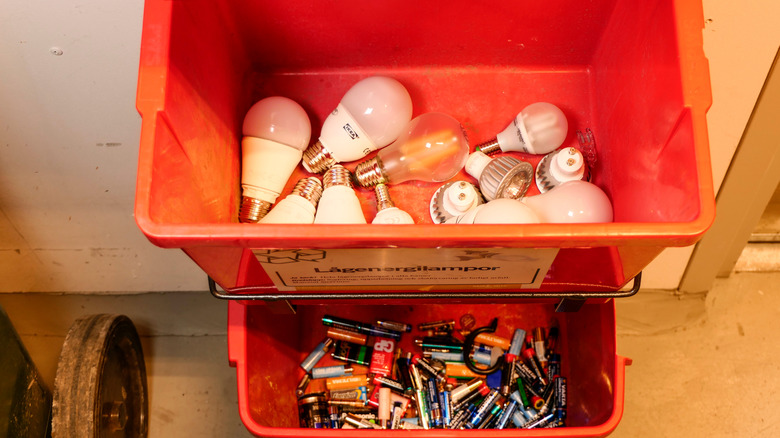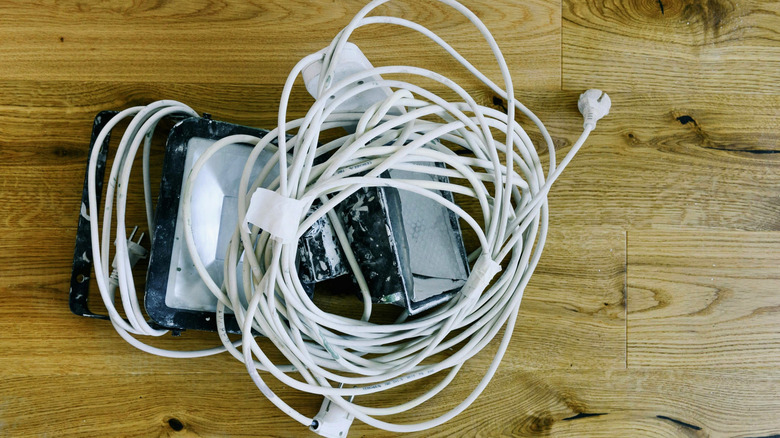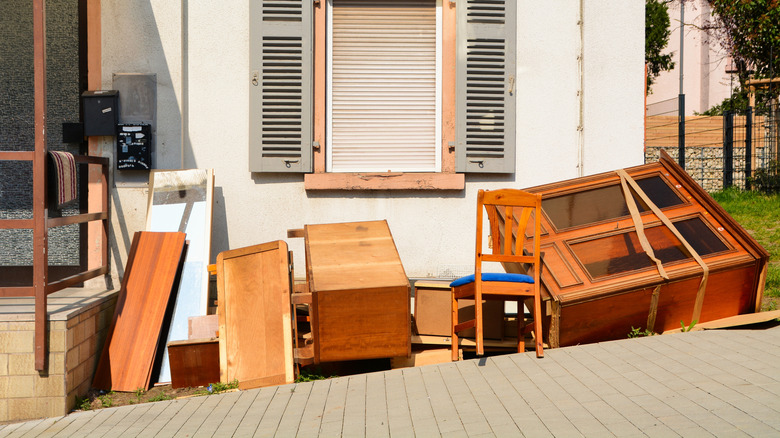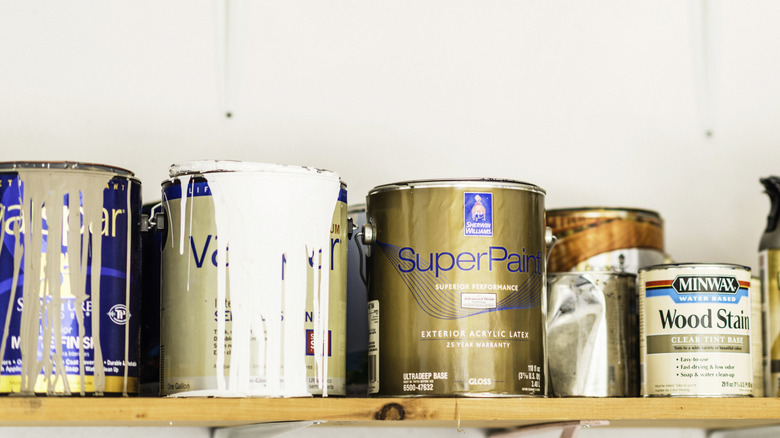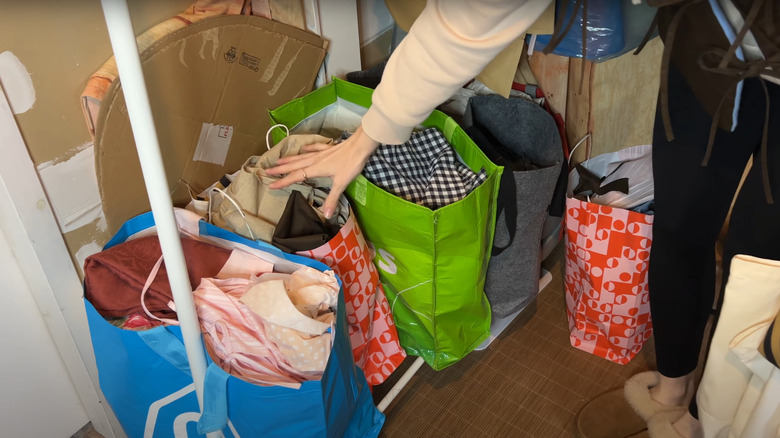Declutter Your Attic By Tossing These 12 Commonly Stored Items
We may receive a commission on purchases made from links.
Attics are "out of sight, out of mind," making them the go-to spot for things you don't need. Because of this, over time, it's easy for this space to become congested with clutter. If your last visit to the attic made you realize how much junk you've accumulated, it might be time to purge the inessentials.
Below are 12 common household items that often take up space in attics. Use this list to filter out what items you don't need, so you can come up with the best strategies for decluttering your home. There are plenty of items you can store in your attic, but that doesn't make it the best spot for storage. Remember, attics are at the topmost point of a building structure. They usually aren't as insulated or ventilated as the rest of a house, making them humid and vulnerable to extreme temperature changes. In fact, attic temperatures can rise to 50 degrees higher than outdoor temperatures, which causes irreparable damage to all types of belongings.
Fortunately, forgotten items don't have to go to waste. Instead of throwing them away, declutter upstairs storage by donating, recycling, refurbishing, upcycling, and selling when you can. Taking them anywhere but the landfill is better for the environment, clears out your living space, and benefits your friends and neighbors.
You don't need niche kitchen tools and appliances
The first priority is to get rid of kitchen appliances when decluttering your kitchen, especially if they're duplicates or worn down. These items oftentimes end up in attics under the vague reasoning that you might need them in the future. Even if you eventually need that second toaster or niche avocado slicer that's stored upstairs, attic conditions aren't kind to long-term storage. Humidity and extreme temperature change severely damage metal, wood, and electrical components. You should also keep in mind that insects and rodents also get into this storage, and there can be a hefty dust buildup as well — these are things most people don't want touching their cooking utensils.
Start clearing out attic kitchenware by sorting it by type. Professional organizer Jen Robin told Real Simple, "Stick to versatile, high-quality [kitchen] options that can handle multiple tasks, and donate or recycle duplicates." For example, do you really need a "Rapid Ramen Cooker" that cooks ramen the same as microwaving it in a bowl? Probably not if you stashed it far away from the kitchen and in your attic.
Move the items you decide to keep to a temperature-controlled area, such as a spare closet. As for the rest, fortunately, kitchen appliances and tools are always in demand. You can try to sell them on secondhand markets like Facebook Marketplace or donate them. Many charity programs like The Salvation Army and other local organizations do scheduled pickups. All you have to do is schedule a visit, and they'll drive over for those kitchen appliances and tools you no longer need.
Broken equipment and tools are better off with someone who can fix them
Gardening, home improvement, and other outdoor tools take up a lot of space. They're often used outdoors and on tasks that cause considerable wear and tear over the years. When items malfunction or don't work as well as they used to, it's easy to replace them with a newer model and toss the older version in storage for a rainy day. These tools are hard to throw away due to their size, price, or electrical components, which is how they usually end up in attics.
Even if your early 2000s garden hedger is fixable, ask yourself if you ever plan on fixing it. If the answer is no, you'd be better off selling it to someone willing to put in that work. The same goes for duplicates, tools you no longer have a need for, or usable but rusted items. There's a high demand for these goods, and plenty of people are on the lookout for valuable tools and home improvement items at garage sales. If you don't want to hold a sale, check out local gardening groups or charities. If you have gently used tools, Habitat for Humanity and local housing associations will take them off your hands so they can sell or rent them for cheap to people in need.
Say goodbye to old Halloween and holiday costumes
Parting ways with memorable costumes isn't easy, especially if sentimental value is attached. It's much easier to shove them into a box upstairs so you can come across it every few years and wallow in your nostalgia. However, consider whether you need those worn-out, faded, and incorrectly fitted costumes. They may have emotional value, but so do photos of you wearing said costumes, which you can back up online or on devices that won't clutter your home. Because of this, you can easily get rid of them and declutter a portion of your attic.
In the book "Don Aslett's Clutter-Free!: Finally & Forever," he recommends cutting a piece from garments you can't let go of. This clears up space while keeping a piece of the memory, making it easier to relinquish the things you'll never use again. If the costume or materials are still in good shape, consider passing them down to others in your family or repurposing them into a new costume. Donations are also an option. Over half of the people polled in a 2024 Goodwill survey say they're more likely to DIY their costumes using secondhand materials. Thrift stores will happily take costumes off your hands when October rolls around, giving your old pieces far more purpose than being stuck up in an attic.
Many outdated electronics are too obsolete to be of use
Technology has really taken off in the past century, and electronics that were just invented a few decades ago are already obsolete in the modern world. Cassette tapes, dial-ups, floppy disks, and tube TV and computer monitors no longer integrate with today's devices. Smart phones are too advanced; most everyday people don't want or need devices with limited capabilities. If you still have decades-old devices stored in your attic, chances are that the batteries are shot and the systems cannot sync with modern programs, making them an easy thing to declutter.
On another note, while a lot of older technology is no longer useful, it hasn't necessarily lost value. There's a high demand for vintage electronics. Millennials who grew up with first-edition Nintendo Game Boys, Apple iPods, and Tamagotchis can scrounge these items out of storage and sell them from $50 to thousands or more online. Old cameras are collectibles; if they're still in the box, they sell for thousands of dollars. Because of this, you need to get these items out of your attic as soon as possible. Dust buildup, humidity, and extreme temperatures destroy their mechanical parts and depreciate their value. Selling isn't your only option. Donate used electronics or drop them off at a major manufacturer's recycling bins. For example, popular chains like Best Buy, Costco, and Walmart have trade-in programs that offer small rewards in exchange.
Take old spare batteries and light bulbs to an electronic drop-off location
Spare household essentials are only useful if they're in good condition. That years-old box of batteries, light bulbs, or other household commodities might not be worth keeping around. Fluorescent lightbulbs contain mercury, and as they age, the mercury can accumulate and become dangerous over time. Unused alkaline batteries also corrode after long periods, especially if left in a place with extreme temperature fluctuations, like attics. If you were saving these spares for a rainy day that never came, they may be out of commission.
Though it's tempting to take the easy way out and throw them out, it's better you don't toss them. They can leak chemicals into the garbage, which is a fire risk and bad for the environment. Corroded, leaking batteries are still recyclable, and you can drop them off at home improvement stores like Home Depot. There are also mail-in recycling programs for batteries and light bulbs. One of the most popular programs is Waste Management's Recycle By Mail Kits, which takes larger collections of defective batteries, lights, and other electronics for a fee.
You don't need all those tangled electrical cables and cords
According to a 2023 Consumer Affairs Report, the average United States home has 21 smart devices alone, all of which come with individual chargers and connector cables. Aside from smart devices, households have cooking, entertainment, and other miscellaneous electronics that also have their own wiring sets. Attics can quickly fill up with excess cables, cords, and wires. Cable management has become a common household issue, and many have to resort to extensive organizers like the 192-Piece Cable Management Kit or try DIY decluttering alternatives. Before organizing all the extra cables in your attic, clear out the ones you don't need.
The biggest concern with cable decluttering is accidentally throwing away one you need. Keep this from happening by matching every appliance and electronic to their corresponding chargers and connectors. Once you have your primary and spare cords set aside, toss duplicates and ones that connect to devices you no longer own. This may go hand-in-hand with clearing out old electronics.
The good news is your cables aren't destined for the trash bin. You can drop them off at the aforementioned major retailers or a local electronic recycler. You can also try posting on a local "Buy Nothing" Facebook group or on Facebook marketplace. Power Bank Expert founder Radu Vrabie told Newtech Recycling he recommends taking chargers, cables, and old wires to recycling plants. "Most of the metal recyclers would pay you something for the effort — especially if you have copper wires in the bin."
Recycle old paper, plastic, or reusable grocery bags you've forgotten about
Many people stash single-use grocery bags when returning from a store, intending to use them for the next shopping trip or other household tasks. When they don't get used, we tend to squirrel them away for a rainy day, often in a place that is out of sight, like the attic. It's easy to forget about something so lightweight and insignificant. Unless you regularly pull used grocery bags from your attic for everyday tasks, consider clearing out the stash.
Grocery bags are an environmental threat. An estimated 5 trillion plastic bags and millions of paper bags are thrown away annually. This is unnecessary since you can use them beyond a one-time grocery trip. Aside from reusing them while shopping, use these bags as packing material, trash liners, and bags for picking up after pets. Aside from repurposing them yourself, take the paper and plastic to designated recycling drop-offs. Plastic Film Recycling's location search bar can help you find a place nearby.
Reusable grocery bags don't need to be thrown out either. Move them to a place where you'll remember to take them on shopping excursions. Try hanging them by a garage door, tucking them into a storage bench by your entryway, or keeping them in the trunk of your car. In 2021, The New York Times reported these bags need to be used at least 20,000 times to negate their environmental impact, which is an extremely tall order. Unless you want your sustainability-minded purchase to be for naught, try using it as often as possible.
Sell or hand down the comic books and novels you're never going to read again
All bookworms can vouch for how difficult it is to part with a beloved novel. Books and comic books have decorative, collectible, and entertainment value, but expansive collections take up too much space to ignore. Leave your downstairs books alone, but consider whether you need all those books stored in your attic. If they're tucked away, they aren't being used as decor or reading material. Another point is that they shouldn't be kept in an attic, even if there's enough space. These areas are prone to extreme heat, high humidity, and pest infestations, all of which can easily destroy hardback and softcover books.
If your books have survived attic conditions up till now, it's time to decide which ones to keep in the main house and which ones to part with. Most people donate their books or sell them at garage sales. If you want to be smart about downsizing, evaluate whether they have value. List and sell first-edition books and rare comic book collections on auction sites to make a real profit. If you'd rather clear out books quickly rather than make a large profit, hand them off to book-selling sites or local libraries. You could even repurpose stored books you aren't reading any more into DIY home decor, though be warned, some book enthusiasts consider this a crime against literature.
Get rid of the travel bags and luggage that have been replaced with newer and better models
There is much online debate over whether travel bags and luggage are okay to store in your attic. They're often bulky and take up valuable space, and the attic is a good place to keep them out of the way. However, keeping them up there leaves them vulnerable to humidity and pests, especially soft-sided luggage that isn't airtight. Uncontrolled humidity and moisture make them moldy, or worse, they could turn into a nest for rodents.
Play it safe and find somewhere to keep your luggage downstairs. When these items are kept in a humidity- and temperature-controlled environment, they're useful for storing other household items. For instance, if you store them in a spare closet, pack them with seasonal clothes or spare bed linens you rotate each half year. If you have a few extra suitcases and carry-ons that you never use, consider getting rid of them to make more room for the luggage you use regularly. You can order one of TerraCycle's Zero Waste Boxes, and they'll recycle backpacks, duffel bags, handbags, totes, and suitcases for a fee. If this idea doesn't appeal, sell or donate them as you would with other viable household goods.
Sell or donate stored furniture before it deteriorates
It's tough to part with large pieces of furniture, like bed frames, cabinets, dressers, and nightstands, especially if there are years of memories behind them. Putting these items in an attic postpones immediate decision-making and quickly clutters limited space. It takes work to maneuver them upstairs, and bringing them down the narrow hatch and ladder is just as difficult.
Most furniture is only good for 5 to 15 years, depending on the quality. In an attic, they degrade rapidly due to humidity, pests, and temperature changes. These environmental factors damage adhesives and glue, warp wood, and enable mold growth in fabrics. Instead of leaving usable furniture in these conditions, sell it on online marketplaces like eBay or Facebook Marketplace. If there aren't any takers, list it as free or offer it up through local "Buy Nothing" groups. It may be tempting to leave it by the road for recycling pickup, but be warned that the EPA reported that over 80% of recycled furniture ends up in landfills anyway.
Toss spoiled paint cans from old home improvement projects
Opened latex paint cans are good for two to five years, while oil paint cans can last up to 10. In both cases, the paints need to be sealed shut and kept in cool, dark locations. Attics are dark, but rarely do they stay at a cool temperature throughout the year. Go through your paint cans, pry them open, and use a stir stick to see if the paint is still an even consistency. If the paint won't blend, has unbreakable chunks in its liquid, and gives off a foul smell, it's time to toss it.
Before throwing away backup paint, make a note of the color and finish. If any of your rooms or items are painted with that color, you may need to purchase more in the future. This takes the guesswork out of buying a fresh can later on.
Unlike other items on this list, there's no way to repurpose spoiled paint. Dry it out little by little by pouring half-inch layers into a plastic bag. Add cat litter or M-1 Paint Hardener for Paint Disposal to make either oil or latex-based paint dry faster. Latex paint is easier to get rid of. Once it's hardened, throw it away with the rest of your garbage. Oil-based paints should be dropped off at a household waste collection facility. Look for companies like PaintCare, which have drop-off points for old paint products in a select few states.
Decide if you really wear the seasonal clothes that never come down from the attic
In a study about decluttering done by The Container Store, 29% of Americans said they had the most difficulty parting with old clothes. You may not think you're a statistic, but reflect on the seasonal clothes currently stored in your attic. If most of your garments are long forgotten, downsizing could free up space. Some clothes might be special hand-me-downs from beloved family members, but you should follow tips to stay optimistic while decluttering family heirlooms. Keeping garments boxed up and unused for long periods doesn't benefit anyone. When you store fabrics in dark and warm spaces, they get damp and moldy, which makes them unsalvageable and unusable.
Separate the seasonal clothes you do wear from the ones you're getting rid of. Find a place for them in a downstairs closet or tucked in a bin under the bed. In fact, extra attic luggage could come in handy here. Remove old suitcases and clothes from the attic and store them together in a place they won't be forgotten. Any like-new clothes that don't fit you, aren't your style, or aren't used should be sold, donated, or handed down to other family members. If any clothes are damaged, smelly, or stained from being in the attic too long, the best option is to toss them.
